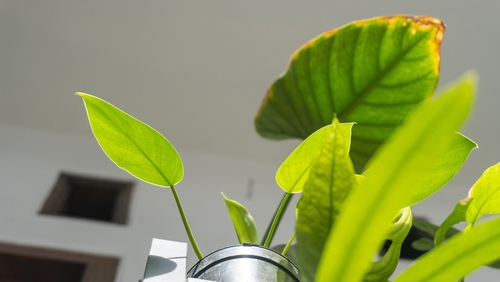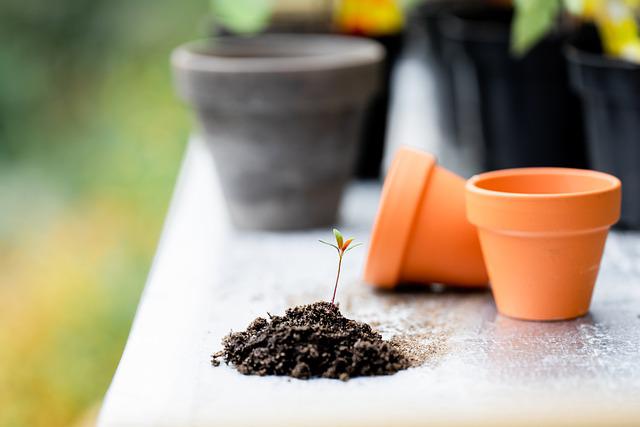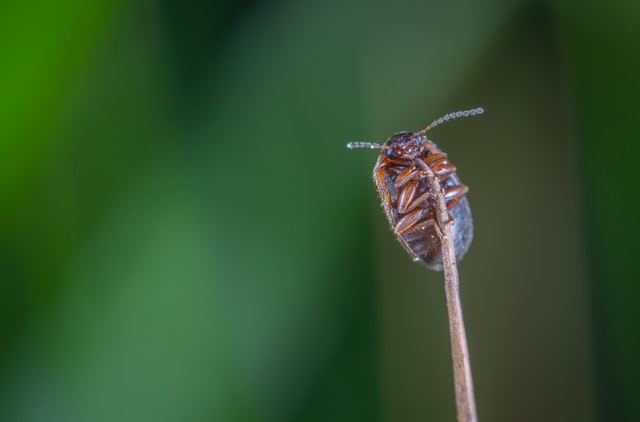If you’re a fan of exotic plants, you should consider adding Anthurium vittarifolium to your collection. It definitely attracts attention with its green, cascading leaves and bright blossoms. Definitely a vibrant-looking exotic indoor plant.
If you’re not sure how to take care of it, keep reading as I show you how to keep this excellent and unusual plant alive for a long time. It is sure to attract admiration from any guests who see it and here’s how to take care of it. Let’s get started!
What is Anthurium Vittarifolium?

The Anthurium vittarifolium is a rare South American indigenous variety. It features long, pendant-like leaves that will brighten up your living space. The plant is thought to be related to the flamingo flower.
It’s an epiphyte species that relies on other plants for support, such as trees. It also likes to grow on the surface of thin layered soil, aside from flourishing in cavities in between tree branches.
It can be found in tropical rainforests in Brazil, Ecuador, and Colombia. Its foliage is similar to the Anthurium pallidiflorum, which is often known as the strap leaf anthurium. Since they look very much alike, they often get confused for each other, and sellers might even sell one plant for the other.
However, the pallidiflorum has a velvety texture, which is probably the easiest method to detect the difference between the two plants.
The Anthurium vittarifolium has glossy leaves and beautiful pink blossoms. When it blooms, the flowers grow on a spadix and spathe, and the berries are pink to violet in color.
This one-of-a-kind jungle plant could even thrive in hanging baskets with its narrow leaves, making it a wonderful plant to display. If given the correct conditions, they can reach a length of nearly 1.5 meters (5 feet). The leaves have the appearance of long leathery green neckties.
Origin and Classification
The Anthurium vittarifolium is native to South America’s tropical rainforests. It is predominantly common in Ecuador, Columbia, Brazil, and Peru. It’s from the Araceae family and is an epiphyte, which basically means that it grows on another plant’s surface and gets its moisture and nutrients from the air, rain, and water around it.
Features of Anthurium Vittarifolium Plant
The Anthurium vittarifolium is an exotic plant that could be a wonderful addition to your garden or even just inside your house, with its eye-catching, long, trailing leaves. The word Anthurium comes from Greek, which means, “tail flower.” Its maximum size is 7.5 to 7.9 feet tall.
1. Leaves
Perhaps the Anthurium vittarifolium’s most striking characteristic is its leaves, with their cascading shape and deep green color. They usually clump together near the stem’s base. They’re slender and long, making this plant an excellent choice for hanging baskets.
They can grow up to 1.5 meters or 5 feet. But some say they can even reach up to an impressive 2 meters in length. They are about 7 to 10 centimeters wide. Due to its magnificent leaves, the Anthurium vittarifolium may give your house a pleasant tropical vibe.
2. Flowers
The spathe and spadix of the Anthurium vittarifolium variegated are pinkish in color. The flowers are used for propagation. If you do not intend to propagate your plant, it is advisable to cut off the blossoms to promote faster development. The flowers are non-fragrant but have a distinctive appearance.
3. Size
Considering where this plant is originally from, it is safe to say that it needs a lot of water, sunlight (but not direct sunlight), and humidity. Given the right conditions, a mature Anthurium vittarifolium plant can reach to about 7.9 feet tall and 4 inches wide.
4. Toxicity

You should proceed with caution in handling this plant, as it is harmful to both humans and animals. Each part of the plant is considered poisonous, so you must take extra care, especially while repotting or propagating it. Keep this plant away from young children and pets. A common symptom of poisoning from this plant is soreness in the tongue and throat.
5. Dormancy
During the chilly winter months, the Anthurium vittarifolium enters into dormancy. Because it is in its rest phase, it does not require much to survive. During this season, it’s better to avoid watering and fertilizing.
Basic Care of Anthurium Vittarifolium Plant
The Anthurium vittarifolium is a species of plant that has breathtaking beauty. It is native to South America’s tropical rainforests. Taking care of it is not as hard as you might imagine. You may be an expert at growing and caring for your green buddy with only a few simple strategies.
Here is a complete guide including light, water, soil, sunlight, temperature, humidity, fertilizing, repotting, and pruning requirements.
1. Size and Growth
As previously mentioned, this plant can flourish up to 7.9 feet tall and 4 inches wide. Its leaves can grow up to 1.5 to 2 meters. To ensure your plant’s growth, it’s vital to space out your watering sessions. Always water the plant moderately rather than soaking it completely. It is vital to allow excess water to drain via the plant pot’s drainage hole. Moreover, make sure it’s free of any debris that could obstruct the water flow.
2. Light Requirements
The plant prefers medium to bright indirect sunlight. Intense and direct sunshine can burn and kill the plant’s foliage and blossoms. For this type to thrive and reach its full potential, partial shade is ideal, about 75-80%.
The Anthurium vittarifolium should receive enough natural, diffused light. Indoors, it might not be a good idea to place your plant immediately in front of a south-facing window. The easiest way to meet your plant’s light needs is to place it 5 to 8 feet away from a window.
3. Water Requirements
Since the Anthurium vittarifolium is native to the tropical rainforest, it has a high water demand. Watering it once every three days guarantees optimal growth and good health for your plant. Watering frequency can be increased up to twice every three days in hotter areas.
Dry conditions are difficult for Anthurium vittarifolium. If it doesn’t have enough water, its leaves might begin to burn from the tip down. On the other hand, overwatering can cause sudden yellowing of the leaves and rotting roots.
You may use your finger to check the topsoil weekly to see if it’s about 50% dry. It doesn’t want to be soggy, but it also likes moisture. You can mist the leaves as well.
4. Soil Requirements

The Anthurium vittariifolium thrives in a well-aerated, well-draining medium with a slightly acidic to neutral pH and adequate water retention.
A good medium should be able to support the roots and stem of the plant so that it does not collapse over as it grows larger, while also providing enough moisture, nutrients, and aeration.
Organic matter, volcanic cinder, or an artificial media (i.e., Rockwool, polyphenol foam) can all be used to anchor roots for plant development and bloom production.
5. Temperature and Humidity
Daytime temperatures of 25 to 32 °C and nighttime temperatures of 21 to 24 °C are ideal for Anthurium vittarifolium. A high temperature causes the foliage and flowers to dry out, eventually causing the plant to fade.
The plant will die if the temperature falls below 16 °C. Keep it away from drafts, heat ducts, and ventilator grills, as it is a delicate plant.
The Anthurium vittarifolium loves moist and humid conditions. High humidity (70-80%) is strongly advised. But do not overwater, as it can cause root damage and abrupt yellowing of the leaves. Let the soil dry out between waterings.
Water every two to three days if you live in a hot area, and as needed if you live in a rainy climate. Remember to lightly spritz the leaves to help with the humidity. Using a humidifier is also a good way to care for it. A cool hack is putting a jug of water near the plant, as the evaporating water will boost the humidity level.
Drying the plant too much will prevent it from growing and will burn the tip. However, during the winter, it prefers to rest for 6 weeks at 15 °C with little water. It encourages the plant to blossom abundantly the next season.
6. Pest and Disease Resistance
To prevent pests and diseases from damaging your Anthurium vittarifolium, it is best to keep your plant and its surroundings clean. You should pinch off unopened flower buds that have been infested by thrips and dispose of them right away to prevent the pests from spreading.
“Anthurium Blight” is the most common disease that affects anthuriums. This is a bacterial infection for which there is no known cure. Once the plant is afflicted and the disease has spread throughout the collection, the only option is to remove it before it infects more plants.
7. Fertilizing
Anthurium vittarifolium roots are extremely delicate, which means that quick-release fertilizers and organic powder fertilizers might cause them to burn. For this reason, some growers use a slow-release fertilizer once a month.
However, the roots are still vulnerable to these feeds. Thus, liquid fertilizers that can be applied as foliar applications are the best option for Anthurium vittarifolium. It can even be used in the garden using water from the surface irrigation system.
8. Potting and Repotting
If you reside in a cool climate area, it is recommended to grow your Anthurium vittarifolium in a pot. Warmer climates would allow for the beautiful leaves to be used for landscaping outdoors. Because this is a plant that demands a lot of moisture, a low plastic pot with adequate drainage capacity would be ideal.
Root rot can be caused by pots that do not have proper drainage. The most often used pot sizes are five, six, and eight inches.
At some point in the future, your plant would have outgrown its pot. Severe root massing at the plant’s base, bulging on the pot’s sides (if it’s plastic), and a general lack of plant vitality are all signs that you need to change its pot.
When new roots begin to sprout, repot your plant early in the year. Fill a 6-7-inch (15-16.25 cm) container with rocks halfway. This will assist your plant in establishing roots in the new media more quickly. Repotting contributes to the plant’s better health and development.
9. Pruning Requirements

When your plant becomes overwhelmed with foliage, it must be pruned. Always begin trimming from the top down and use disinfected gardening tools. Remove the burnt, wilted, and yellowing leaves while being careful not to damage the healthy leaves.
Eliminate any dead flowers that are still clinging to the plant. Take the seeds from the flowers before discarding them if you want to propagate this amazing plant.
How to Propagate Anthurium Vittarifolium
There are two methods to propagate the Anthurium vittarifolium: division and cutting. The anthurium will produce numerous plants from the same container over time.
You can make several plant clones from a single plant by carefully dividing the mother plant. Additionally, division will provide each plant with actively growing roots, allowing for speedier plant recovery.
On the other hand, propagation through cuttings requires more patience and preciseness. It may sound challenging, but just follow these steps:
Step 1
Pick a section includes at least two nodes and has already sprouted aerial roots.
Step 2
Use a sharp, sterilized knife or pruning shears to cut the leggy growth of the Anthurium vittarifolium. Take extra care while handling the knife or shears.
Step 3
Clean and prune the cut section. Peel off the brown, leaf-like husks and remove yellow or shriveled leaves. At this point, you should cut the remaining flowers off too, as the plant will grow new ones eventually.
Step 4
Remember to keep them humid around the roots, but not soggy.
Step 5
Transplant them into a potting mix, which constitutes the same media from the mother plant’s pot. Make sure the new pot has a good drainage system as well.
Step 6
Be mindful of the right levels of sunlight, water, temperature, and humidity for the perfect conditions for this precious plant.
Step 7
Be patient! The cuttings will take several months to grow to full size.
Common Problems Caring For Anthurium Vittarifolium
Congratulations! You have propagated your Anthurium vittarifolium successfully. You should now look out for some common problems in caring for this rare species. Here are the four most common issues that you need to look out for.
1. Yellow Leaves
Yellow leaves could either mean overwatering or overfeeding with nutrients. Try not to feed it for some time and just simply water it. If the problem is not resolved, try the other way, do not water it for a week and let the soil completely dry. Check if the pot has proper drainage as well.
2. Brown Leaves
Brown leaves can be caused by the following factors: too much sunlight, nutrients, lack of water, and diseases. Make sure your plant has the right conditions mentioned earlier for it to thrive.
Unfortunately, if your plant has been infected by bacteria and has Anthurium Blight, there is no known cure. You should separate and destroy the infected plant before it spreads to the other plants.
3. Black Spots on Leaves
Black spots could also mean that your plant has been infected with Anthurium Blight disease. When the plant’s humidity is too high, bacteria develops. So, keep an eye on the humidity level around your Anthurium vittarifolium from time to time. Too much sunlight and a lack of water can both generate black spots.
4. Other Pests

Mites, snails, worms, slugs, thrips, and whiteflies are the most prevalent pests that attack the Anthurium vittarifolium. These insects usually disfigure flowers and leaves. If you notice these pests early on, wash the leaves using insecticidal soap and water.
Make sure the plant surroundings are also clean. Remove infected flowers and leaves immediately.
Learn more from a similar post: Paraiso Verde
Outro
As you have read, the Anthurium vittarifolium is a splendid species from South America, which is the perfect addition to your growing collection.
It can give your garden or house a tropical vibe, with its majestic, long, deep green leaves, cascading from hanging baskets. Even its flowers are such a beauty! It thrives on high humidity and medium to bright indirect sunlight.
Frequently Asked Questions
How do you care for Anthurium vittarifolium?
Make sure that it has medium to bright indirect sunlight. Water it once every 3 days. The soil should be well-drained and well-aerated. Choose a pot with an adequate drainage system.
The temperature should be between 16 and 24°C (60° to 75°F). High humidity (70-80%) is strongly advised. Lightly spritz with water to keep its moisture or use a humidifier.
When should I repot Anthurium vittarifolium?
Repot it after it has doubled in size or once a year, whichever occurs first. Other signs that indicate that you need to repot are severe root massing at the plant base, protruding on the pot’s sides, and lack of plant vitality.
You shouldn’t need to add fertilizer because new potting soil contains all the nutrients your plant requires. Plants acquire their energy from the sun.
What is the most rare anthurium?
With its big, velvety green, heart-shaped leaves, crisp white venation, and coppery-hued underside, the Anthurium crystallinum stands out among other foliage houseplants. This is a very rare find that plant aficionados are clamoring for.

Hey, I’m Lisa and I’ve been an avid gardener for over 30 years. I love writing, talking and living in the garden! Feel free to connect with me on my socials below

![Anthurium Vittarifolium Plant, Grow & Care Guide [year]](https://gardeningfaqs.com/wp-content/uploads/2022/06/shutterstock_2078710978.jpg)